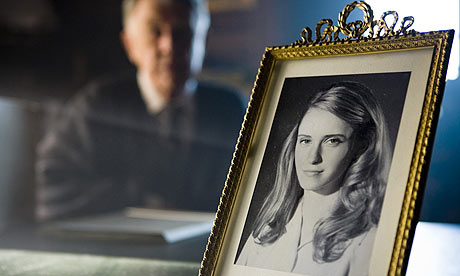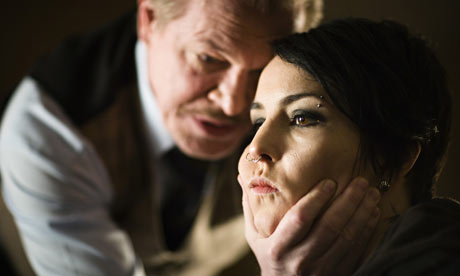
The Girl referred to in the title of The Girl with the Dragon Tattoo is Lisbeth Salander. Lisbeth Salander is a motorcycle riding, chain-smoking, black-clad, silent-with-rage anti-hero who happens to be an expert investigative journalist and hacker. As played by Noomi Rapace, she is antidote to beautiful enigmas like Liv Ullman. Salander is an enigma of scars, a mystery of utter cynicism and inner torment. In this sense, she is not even an anti-hero, because there is no hero for her to be the antithesis of. Her image and her skills are the end product of an obsessive personality and of a disturbed past, which never really went past. She is not the icon that she would be in an American movie; she is a downtrodden figure, one of the unfortunates of society who cannot escape abuse from men. She is one of the many women in the original Swedish title, “Man Som hatar Kvinnor”; Men who Hate Women.
The Girl with the Dragon Tattoo is based on the novel by the late Stieg Larsson. It is the first in a trilogy that he completed before his early death, though in fact, it is just one of the numerous books in a strong movement of Swedish mysteries. Tattoo is the most blockbuster of any of the books. It is a gloriously trashy novel that manages to sustain a socio-political theme throughout; it is a total page-turner that mixes virtually all sub-genres of the mystery novel, yet is far grimmer in its view of the world than any other page-turner.
It was impossible not to make in to a movie, and not just because of its success; first of all, the story hinges on the vitality of imagery. One of the first images we see is a picture of the smiling Harriet Vanger, a girl who dissapeared some forty years ago (the actual time of the story can be pinned around 2004). Her uncle Henrik (Sven Bertil Taube) hires Mikael Blomkvist (Michael Nyqvist), a journalist recently flagged with a libel suit from a competitor, to investigate her dissapearance. Blomkvist moves on to the wealthy Vanger family’s estate, interacts with the variously shady and disgruntled family members and investigates the many photographs of Harriet on the day of her dissapearence. But then he meets Lisbeth Salander. Salander has been introduced to us a wayward girl who has recently come under the custody of a new guardian. He turns out to be an evil, opportunistic man who rapes her. Salander deals with him--how does not require explanation here-- but finds her ongoing situation of abuse mirrored in the case of Harriet Vanger. However, the only reason she signs on to the case in the first place is because of her encounter with Blomkvist’s set of photographs, on the hard drive of his computer that she has been hacking for a report on his libel suit. When Blomkvist finds out who she is, courtesy of a vital clue to the case that Salander tips him off with, the two of them delve in to an investigation in which they discover further collections of imagery that become more and more brutal, revelatory and immoral.

(Noomi Rapace and Peter Andersson in The Girl with the Dragon Tattoo)
As a film, the book that The Girl with the Dragon Tattoo has to live up to is a tall order, so the most practical task of director Niels Arden Oplev is to improve on its flaws and condense its strengths. He does this task well. Gone are the silly affairs that Blomkvist has in the book, and the tiring final eighty pages is here condensed to a cool and swift ten minutes. But then, gone is the lived-in workplace experience evident in the book; the underlying setting of the story is the world of journalism, one which Larsson clearly knew well, but which must be seen from the remove of a cinema screen here. It does not particularly matter in the end; the lived-in world of journalism is replaced, quite simply, with the lived in world of modern Sweden. At precise intervals, we see striking landscape shots of the countryside, which the events of the story temper with a stormy feeling of danger. Interiors are always darker than they should be, or clinically light; the only exceptions to this rhythm are several brief scenes of Blomkvist’s domestic life, and at the very end of the film. Faces of characters are often split in darkness; they are just as frequently bloodied, bruised or somehow suspicious. Writers Nikolay Arcel and Rasmus Heisterberg, thankfully, did not feel the need to be slavishly devoted to the book; background information about Salander’s traumas that did not appear in the first book is shown here, and some scenes are rearranged. The film manages to sit comfortable in between pulpy genre blockbuster and Scandinavian angst film depicting an amoral society.
If the final scene feels too heroic, too schlocky in its sequel-hinting, consider this a sad form of permission for Hollywood to remake the film (David Fincher is scheduled to direct). It is doubtful that a remake would dare to utilize the genuine human pathos evident in this film. One wonders if it would still show the brutal implications of imagery. Whether it is imagery carved on the skin of a man, or photographs that both suggest a nations past and what became of a little girl, this is a film which--however sensationalistic-- believes that this brutality is worth getting on screen.





